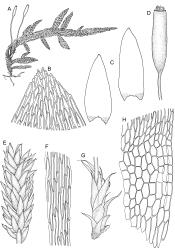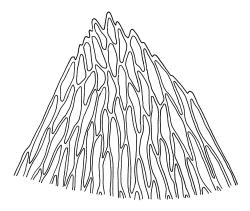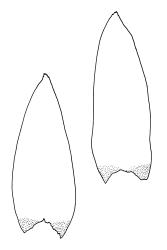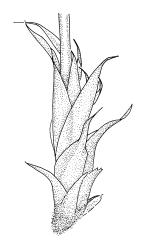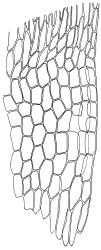- = Entodon truncorum Mitt. in Hooker, Handb. New Zealand Fl. 467 (1867)
- = Entodon beckettii Müll.Hal. in Dixon, Bull. New Zealand Inst. 3: 277 (1927) nom. inval.
Plants moderately robust, bright green, occasionally bronze, and lustrous when fresh, becoming yellow-green in herbarium, forming loosely interwoven and flattened mats. Stems c. 40–70 mm, irregularly to sub-pinnately branched, in cross-section oval, with 2–3 layers of firm-walled, pigmented cortical cells and an ill-defined but large central strand. Shoots complanate or sometimes homomallous, usually tapered to a cuspidate and ± secund apex, c. 2.0–3.0 mm wide. Branches mostly short and cuspidate-hooked at tips. Stem and branch leaves strongly complanate or ± homomallous, oblong-lanceolate, slightly auriculate at base, acute and often slightly curved to one side at apex, strongly concave, entire except for a few small apical teeth, c. 1.8–2.2 × 0.8–0.9 mm; margins plane or loosely incurved; upper laminal cells weakly sinuose, mostly 78–115 × 5–6 μm, becoming shorter at apex; basal cells shorter, broader, and ± porose to form a broad but ill-defined band, which grades into the alar group; alar cells inflated, broadly oblong and rather thin-walled, not porose, the largest c. 35 × 20 μm, the cell contents persisting as a primary utricle when dry, forming a large, moderately defined, concave, and ± auriculate group, mostly extending 8–10 cells up the margin and to 1/3 the basal width of the leaf. Costae absent or very faint, short, and double.
Autoicous. Perichaetia with outer leaves widely spreading, the inner narrowly lanceolate, apparently elongating after fertilisation and weakly sheathing the seta base. Perigonia scattered on stems and branches, axillary, gemmiform, often sparse, with ovate and widely spreading bracts, numerous antheridia, and filiform paraphyses. Setae yellow or pale-brown, straight or weakly flexuose, 10–15 mm, twisted to the left; capsules erect and narrowly cylindric, not constricted below mouth, 3–4 × 0.7–0.9 mm, smooth and scarcely altered when dry; exothecial cells irregularly oblong, firm-walled; stomata superficial, sparse and restricted to capsule base; annulus not seen; operculum obliquely rostrate. Exostome teeth red, c. 500 μm long and inserted c. 75 μm below the mouth, on outer surface with a nearly straight median line and broad plates, striate, on inner surface scarcely trabeculate; endostome arising from a very low basal membrane, segments linear, ± equal the teeth, narrowly perforate, keeled, and smooth; cilia lacking. Calyptra smooth, c. 3 mm. Spores 15–18 μm green, finely papillose.
Buck 1990, figs 6–10; Whittier 1976, fig. 89 (as E. solanderi).
Study of Buck’s (1990) detailed description and illustration of E. plicatus and examination of a suite of Sri Lankan, Australian, and Polynesian collections confirms that N.Z. E. truncorum is identical to the widespread E. plicatus; Buck’s (1990, p. 701) suggestion that N.Z. material differs from extra-N.Z. material is rejected here.
Townsend (1991) provided notes on Entodon in India and Sri Lanka and proposed that E. plicatus Müll.Hal. should be placed in the synonymy of the widespread American species E. macropodus (Hedw.) Müll.Hal. However, Buck (pers. comm., 10 Aug. 2002), who has worked extensively on this family, considers these species to differ by peristome characters and thus Townsend’s synonymy is not accepted here.
Populations in which the leaves are decidedly homomallous could, if sterile, be confused in the field with rather large forms of Hypnum cupressiforme. Usually, however, the present species has leaves that are only secund at the stem-branch apices in contrast to the markedly falcate-secund leaves of the Hypnum. The nature of the alar cells in the two species is very different, as is the sexuality and the nature of the sporophyte.
NI: Gisborne (Lake Waikaremoana), Hawke’s Bay (Tukituki River), Wellington (Wairarapa); SI: Nelson, Marlborough, Canterbury, Otago, Southland; Ch.
Anomalous. Mainland Australia*, Rarotonga*, Sri Lanka*, India*. Also reported (Buck 1990) from Mauritius, south-east Asia, East Indies, Philippines, Tasmania, New Caledonia, Fiji, and Hawai’i.
On a wide range of rocks, exposed roots, and occasionally on logs or tree bases in forested habitats where it can form mats to at least 250 mm diam. Occurring from c. 30 m (Wairarapa, Wellington L.D.) to 1070 m (Red Hills, Marlborough L.D.) elevation. This species is poorly documented on the North I. from whence fewer than 10 collections have been seen, most of them from the Lake Waikaremoana vicinity. It is a relatively common species in the foothills of Canterbury where it occurs mostly on greywacke. However, in Marlborough, Nelson, and Southland L.D. it is usually associated with limestone or marble. Occurring in a variety of forest types and frequently associated with Acrocladium chlamydophyllum, Camptochaete spp., Echinodium hispidum, and Rhacocarpus purpurascens. Dixon (1927, p. 277) recorded this species (as E. truncorum) only from Canterbury and Otago L.D. Although it is now known to be more widespread and to occur on both main islands, approximately ⅔ of the known N.Z. collections are still from these two Land Districts.
Stems of E. plicatus are relatively robust and variably complanate; many populations have leaves only weakly ranked and decidedly homomallous. In terms of leaf cell and sporophyte characters, however, the species is less variable. The oblong-lanceolate, weakly doubly costate or ecostate leaves, which are asymmetric and denticulate at the apex, are distinctive, as are the large groups of enlarged and oblong alar cells. The commonly-produced erect and narrowly cylindric capsule with its distinctive double peristome makes this species readily recognisable in N.Z. The exostome teeth have broad, striate plates separated by a nearly straight median line and lack adaxial trabeculae. The endostome with a very low membrane, elongate segments, and no cilia provides further distinction.




